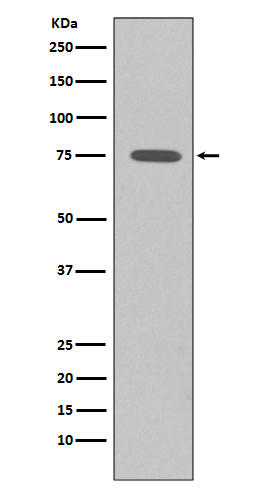产品名称
Somatostatin Receptor 2 (8M8) Rabbit Monoclonal Antibody
别名
SSTR2; somatostatin receptor 2; SS 2 R; SS2R; SRIF 1; SS2 R;
纯度
Affinity-chromatography
存储缓冲液
Rabbit IgG in phosphate buffered saline , pH 7.4, 150mM NaCl, 0.02% New type preservative N and 50% glycerol. Store at +4°C short term. Store at -20°C long term. Avoid freeze / thaw cycle.
Human Swissprot No.
P30874
稀释度
WB 1:1000~1:2000 IHC 1:50~1:200 IP 1:50
注意事项
Somatostatin Receptor 2 Antibody is for research use only and not for use in diagnostic or therapeutic procedures.
组织表达
Expressed in both pancreatic alpha- and beta-cells (at protein level). Expressed at higher levels in the pancreas than other somatostatin receptors. Also expressed in the cerebrum and kidney and, in lesser amounts, in the jejunum, colon and liver. In the developing nervous system, expressed in the cortex where it is located in the preplate at early stages and is enriched in the outer part of the germinal zone at later stages. In the cerebellum, expressed in the deep part of the external granular layer at gestational week 19. This pattern persists until birth but disappears at adulthood
细胞定位
Cell membrane; Multi-pass membrane protein. Cytoplasm. Note=Located mainly at the cell surface under basal conditions. Agonist stimulation results in internalization to the cytoplasm
功能
Receptor for somatostatin-14 and -28. This receptor is coupled via pertussis toxin sensitive G proteins to inhibition of adenylyl cyclase. In addition it stimulates phosphotyrosine phosphatase and PLC via pertussis toxin insensitive as well as sensitive G proteins. Inhibits calcium entry by suppressing voltage-dependent calcium channels. Acts as the functionally dominant somatostatin receptor in pancreatic alpha- and beta-cells where it mediates the inhibitory effect of somatostatin-14 on hormone secretion. Inhibits cell growth through enhancement of MAPK1 and MAPK2 phosphorylation and subsequent up-regulation of CDKN1B. Stimulates neuronal migration and axon outgrowth and may participate in neuron development and maturation during brain development. Mediates negative regulation of insulin receptor signaling through PTPN6. Inactivates SSTR3 receptor function following heterodimerization.

